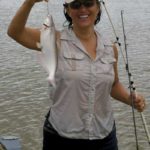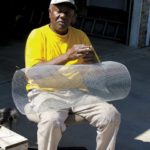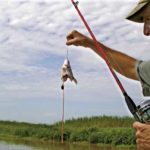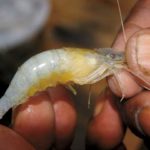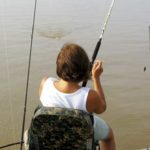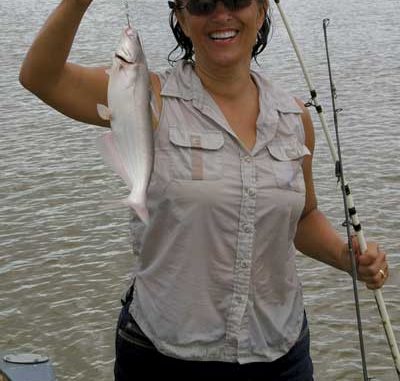
Load up on river shrimp, and you’ll soon be loading up on delicious Atchafalaya River catfish.
There are some things that are hard to admit. There are also other things you may never live down. Take Bill Buckner’s error in the 1986 World Series for example. Buckner’s error with two outs in the bottom of the 10th allowed the Mets to go on to win game six, knotting the series at three games apiece. You know the story — the Mets won game seven and took the Red Sox four games to three to become world champions. Buckner, a prolific major league hitter, now living in Idaho, will never live it down.
How about Appalachian State this past fall beating the most storied program in collegiate football at the “Big House” in Ann Arbor, Mich. Michigan didn’t get LSU coach Les Miles, and it will take new coach Rich Rodriguez quite some time to help the Wolverines live that game down.
Then there’s a certain former president — never mind, I won’t go there, this being an election year. Nonetheless, let’s just say he’ll never live it down.
What I’ve learned in life, the best way to live things down is to just get it out in the open and let the chips fall. Admitting the truth allows a sort of cleansing of the soul that lets you sleep at night.
So here goes — my wife Christine just might be more of a diehard fisherman than me. What’s more, when it comes to fishing catfish on anchor, she beats the living daylights out of me, catching more fish, nearly every time we go — especially, downriver starting from Morgan City.
Each spring, folks gather under the bridges in Morgan City, which usually signals the run for blue cats is on. Typically, the run starts in April — give or take a week — though much depends on the flood stage as the river always has a spring rise and subsequent fall.
Local fishermen driving to work each morning do the chicken neck thing and crane to see if boats are on anchor below the tri-city area bridges that join Morgan City and Berwick. Like farmers who drive rural country roads scanning their crops, these recreational anglers look north toward the Berwick locks joining Bayou Teche to the Atchafalaya River and then south to where the river transects the Intracoastal below the train-trestle bridge.
You can take it to the bank, when just one boat is anchored out on the water below, the morning commute to work is going to cause that guy to quit listening to talk radio. No, he’s going to lose all consciousness of the topic of the day and start strategizing whether or not he has enough time after work to get a line wet and still get to Junior’s Dixie Youth baseball game that evening.
Such was the case with me. When I mentioned the boats to Christine, her Cajun statement question was, “So, you’re taking tomorrow off and we’re going?”
“Not exactly,” I replied. “What about Saturday?”
Such things have to be planned. Friday evening I would make a stop in Patterson at Rogers Bartley’s house to pick up some river shrimp, stop and pick up ice, go home and hook up the boat, plus load the rest of our gear.
Bartley, 59, is a commercial fisherman who packages and sells river shrimp to local anglers, besides fishing catfish himself. He knows the Atchafalaya River, and each spring he may put out anywhere from 30 to 70 shrimp traps to satisfy the needs of recreational fishermen as well as his trot lines. And, occasionally, when he has the unction to pull out his own rod and reel, it doesn’t hurt to have enough on hand for personal use.
Conduct a poll of what is the best bait to use, and the vast majority of those cat fishermen on anchor below those bridges will agree — river shrimp.
“I’ve always used river shrimp,” Bartley said with confidence from years spent in the marshes south of Morgan City. “I’ve tried cut mullet, shad and beef tongue, but I’ve murdered the catfish on river shrimp.”
For the analytical person wanting to speculate on why river shrimp are so effective on catfish, this isn’t like fishing for more glamorous fish such as bass and sac-a-lait with artificial lures. It doesn’t take a lot of figuring out.
Egg-laden river shrimp are in the grassy shallow water tributaries doing what they do with all of those eggs — laying them in the grass up and down the river. Blue cats happen to be running, and river shrimp happen to be their primary food source.
Find a good place along the river where catfish are biting, and hook on a river shrimp; odds are you’re going to catch fish. Can you substitute saltwater shrimp? Sure, but river shrimp are better.
“When catfish start coming up into the rivers, they more or less feed on those river shrimp,” Bartley said. “A lot of times you can get them to hit on saltwater shrimp, but it’s not as good as the freshwater shrimp. I guess maybe the eggs that the shrimp have are like a delicacy to them.”
From a tactical standpoint, again, this isn’t like bass or sac-a-lait fishing. It’s on anchor, and your line stays in the water until a fish happens to take your bait. The tactics boil down to rigging for river fishing in order to maximize your time on the water catching 1 1/2 to 2-pound fish — producing perfect fillets for frying.
When you see the way Bartley rigs his pole for catfish, the first thing you’ll notice is there are no swivels.
“If you got to go to Wal-Mart to get it, we don’t use it,” he said. “I see a lot of people going in to Wal-Mart spending $1.50 on a rig, $2 for a leader — that’s more than $3 right there going down the drain.”
The set-up is a double-hook arrangement with a weight at the bottom. Where most anglers use three-way swivels, Bartley ties his two hooks off the main line with the weight at the bottom. The first 1/0 hook is tied with a square knot roughly 18 inches above the weight, and the second hook 36 inches above the weight. Both hooks stand off from the main line, approximately 12 inches.
Bartley explained the method he has used all of his life.
“A lot of times, your catfish are not going to feed on the bottom,” he said. “He’ll feed just off the bottom on small fish and the stuff that comes by. The majority of time when you get into a bunch of catfish, you’re going to catch two at a time.”
Sydney Rock, also of Patterson, has fished and spent time with Bartley downriver over the years. The 56-year old former Halliburton employee and commercial crab fisherman limits his line size, when fishing catfish, to 15-pound-test.
All I ever use is 15-pound-test,” he said. “If he breaks it, the fish is too big and I don’t want it. If you got your drag and everything set right — and you do catch a big fish — it’s a fight, but you’ll catch it.”
Due to the river’s swift current, the size of the weight utilized on tight-line rigs is important.
“I use a 1 1/2-ounce weight because of the current,” Bartley said. “Any little fish that hits it, you’re going to think you got a monster on it. But that 1 1/2-ounce weight — I don’t care what size fish it is — he can take it and run with it.”
When looking downriver for a place to anchor and catch fish, recreational anglers, according to Rock, can target several areas starting in Morgan City.
“Conrad’s Shipyard all the way down to the train bridge is good,” he said. “In April, they’ll really start fishing the east side of the river bank, and you’ll see all the way down the river tight lines and everything else.
“On the back side of Fools Point as you leave the Berwick landing is good. Chicken Island Pass — all that area — is good and, believe it or not, Shell Island Bayou is good. But last year, most of the fish caught in Morgan City were caught by the train trestle.”
For anglers wanting to catch big catfish on a rod and reel, Bartley recommended fishing deep holes, particularly Big Wax Bayou where it meets the Atchafalaya River below Sweet Bay Lake near Lake Salve.
“If you’ve got a depth finder and go find a deep hole … you’re going to find big fish, but you can’t catch them with river shrimp,” Bartley said. “You got to use cut bait, like shad, mullet or something like that. You just drop it straight down. I think some of those areas have 30 feet of water in there. That’s where your big fish are going to be, especially where those old trees have collapsed down in the bayou.”
Another good area, just west of the main river, that Bartley suggests is Doctors Bayou.
“A lot of people think because it only has 5 or 6 feet of water, there’s no fish up in there. I’ve got trot lines in there,” Bartley said. “Where you’re coming out of the Wax, where Lake Salve and all that is — certain time of year — when they’re fishing up under the bridges at the same time, I’ll be right there. I’ve come in with four or five ice chests full of fish, right in that little area.”
When Saturday rolled around, Christine was up before me with the coffee on, packing us some snacks to munch on.
I heard her singing something like, “Goin’ fishin’ instead of just a-wishin’,” in a key I wasn’t familiar with, and I knew I was in for another catfish whipping at the hands of this fishing homemaker.
I told her we would start in Morgan City beneath the bridges and work our way downriver.
Launching in Berwick, we made our way over to Morgan City, but the boat ride was little to be desired. The barge traffic, in addition to the breezy conditions, made the going rough, and I noticed Christine was struggling a bit when we finally anchored near the train trestle, close to the Mr. Charlie Offshore Rig museum.
In seconds, Christine had a river shrimp on a hook and “zzziiinnnggg” went her line landing right in the vicinity of the drop-off, where it needed to be. But, suddenly, Christine leaned over the side of the boat and up-chucked — nothing dainty and demure about this situation.
“Christine! Girl, are you all right?” I implored.
Only to get the hand and a reply, “Don’t look at me! I’m alright, go ahead and fish.”
“Do you want to go home? We’re only 10 minutes from the landing,” I said, talking to the hand.
“I’m alright — do I have a fish on my line?” she asked in sort of a spitting mumble.
“Ooh — uh yeah, I think so,” I said.
Christine rose from leaning over the side of the boat, and gave a yank on her pole, reeling the blue cat in, only to lean back over the side.
After catching a few cats under the bridges, Christine still was leaning over the side of the boat with regular episodes of … well, yeah, not pretty.
“Let’s go to Fools Point,” she said. “I’ll be alright!”
Man, I thought to myself, what a diehard. I ain’t sitting out here feeling like that. Not for catfish — maybe offshore for bigger game fish — but not this.
Suddenly, I realized I was never going to live this down if she beat me fishing while sick. And the way she had been yanking on her pole, there was a pretty good chance that was going to happen.
At Fools Point, with Christine less over the side of the boat, I was able to turn the table in my favor, but the truth is she had to be sick for me to do it.
